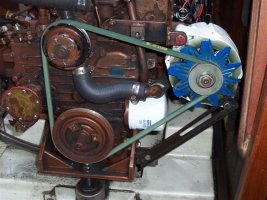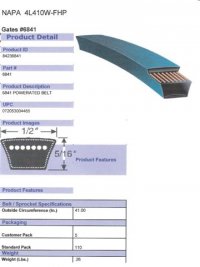More on alternators
Leese Nevilles are the only hot rated alternators on the market, despite others claims.
What you can generate and what you can use are two different things....
If you go with a fairly standard cruising set up, say a 100 amp alternator, and a house bank of say 750 amps. Your usage dictates how often you charge. However being kind to your batteries and not letting them fall below the 50% charge rate, means that by and large the 100 amp alternator is going to charge at 100 amps for about 5 minutes, then drop down to probably about 60 amps give or take.
Charging with your main engine if you are not motoring is not very good for the engine, and since they are expensive to replace, I recomend something that will swing a good alternator use less fuel, better match the load, and is substancialy cheaper if you are going cruising. If you are hanging out and day sailing then your normal motor in and out of the harbor, or when there is little wind, or the wrong direction will probably make the main engine and a good alternator/regulator combination a fine choice.
The Honda generators seem very suseptable to salt air death, judging from the people that had them when we were out cruising.
A good regulator is a must!!!! Not the one that comes in the alternator, this is the big difference.
Larger case alternators do cool better.
Belts do come in different tapers, but they are rare.
I have field rebuilt a few dead balmars. One of my big money makers out cruising is rebuilding alternators. Generally the are killed by their owners in one fashion or another, but some just die...
If you are really worried about heat, you can remote mount the diodes, use arc welding diodes, get say 200amps at 14 volts designated ones, and mount them to a heat sink. Will keep all of the heat out of the alternator, and it will generate more than the rating by a long shot.
There is a lot that can be done with alternators and regulators, I could fill whole chapters on each. Without even going into the odd installs like remote diodes, water cooling, double fanning etc.
Guy




 I do get much longer belt life and a lot less dust, it's green, though. I can't find any real specs on the belts so I can't explain anything.
I do get much longer belt life and a lot less dust, it's green, though. I can't find any real specs on the belts so I can't explain anything.